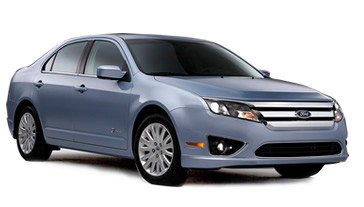Hybrid Electric Vehicles (HEVs)
In this section

Hybrid Electric Vehicles (HEVs)
Ford Fusion
Hybrid electric vehicles are powered by a traditional internal combustion engine and battery power to deliver improved fuel economy. By the end of 2012, Ford will be North America’s largest maker of hybrid transmissions.
2007Begin migration to advanced technology |
2011Full implementation of known technology |
2020–2030Continue deploying advanced powertrains and alternative fuels and energy sources |
|---|---|---|
Hybrid Electric Vehicles (HEVs) |
||
Ford introduced its first hybrid in 2004, the Ford Escape Hybrid, which was also the world’s first hybrid SUV. We followed up with the Mercury Mariner Hybrid in 2005. In early 2009 we further expanded our hybrid vehicle lineup by introducing the Ford Fusion and Mercury Milan Hybrids, which offered class-leading fuel efficiency. In 2010, we launched the Lincoln MKZ Hybrid, which was the most fuel-efficient luxury sedan in America at the time it launched. Unique among hybrid vehicles, it is available for the same manufacturer suggested retail price (MSRP) as the gas model MKZ.
All of our hybrid vehicles use Ford’s powersplit architecture, meaning they can run exclusively on battery power, exclusively on gas power or on a combination of both to deliver the best overall fuel efficiency. We are currently increasing our hybrid volume, and preparing for hybrid capability across our highest-volume global product platforms.
The newly redesigned Ford Fusion, launching in 2012, is the first sedan to offer gasoline, hybrid and plug-in hybrid powertrains, underscoring Ford’s commitment to giving customers the power of choice in fuel-efficient technologies. Each model is expected to have unsurpassed fuel economy in its respective segment. The all-new Fusion was named Best in Show at the 2012 North American International Auto Show, a rare honor for a mid-sized sedan. The new Fusion Hybrid will feature an all-new 2.0L Atkinson-cycle four-cylinder gasoline engine, which is significantly downsized from the previous 2.5L unit while maintaining performance standards. This innovative powertrain is anticipated to deliver best-in-class fuel economy of at least 47 mpg in city driving and 44 mpg on the highway. The Fusion Hybrid continues to innovate and evolve with all-new lithium-ion batteries that save weight and generate more power than the previous nickel-metal-hydride batteries, while raising the vehicle’s maximum speed under electric-only power from 47 mph to 62 mph.
In 2012, Ford will also introduce a hybrid version of the Ford C-MAX multi-activity vehicle in the U.S. This will be one of three electrified vehicle options based on our C-platform. The others are the Focus Electric (a battery electric vehicle, or BEV) and the C-MAX Energi (a plug-in hybrid, or PHEV).
The C-MAX Hybrid will use the Company’s powersplit hybrid architecture, with improved fuel efficiency and a lighter, smaller lithium-ion battery system. Some key advancements of this technology include:
- Electric motors capable of operating at higher electric speeds
- Optimized gear ratios, allowing for improvements in fuel economy
- More precise controls to deliver higher levels of refinement as the powertrain transitions between engine and electric drive
- Reduced weight to help increase fuel economy
With the launch of the C-MAX Hybrid and C-Max Energi, Ford becomes North America’s largest maker of hybrid transmissions.
Our next-generation hybrids will also have a suite of driver information systems to help drivers maximize fuel efficiency. This includes an updated version of the SmartGauge™ with EcoGuide instrument cluster that coaches hybrid drivers to maximize fuel efficiency, along with an enhanced version of the MyFord Touch™ driver interface system that can be configured to show different levels of information, including fuel and battery power levels, as well as average and instant miles per gallon.
